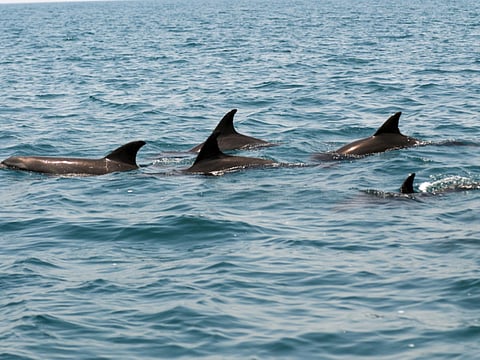Abu Dhabi proves a haven for humpback dolphins
Survey highlighting largest population of Indian Ocean species stirs scientific interest worldwide

Abu Dhabi: A survey has found that Abu Dhabi has the largest population of the Indian Ocean humpback dolphin. ‘Dolphin Survey’ conducted by the Environment Agency - Abu Dhabi (EAD) estimated that 701 Indian Ocean humpback dolphins and 1,834 Indo-Pacific bottlenose dolphins inhabit Abu Dhabi’s coastal waters. This Indian Ocean humpback dolphin population in Abu Dhabi is the largest ever reported for this species in the world, said an EAD press release on Sunday.
The next largest population (466) is found in South Africa and other populations that have been estimated are typically very small — Mozambique (105), Kenya (104) and Tanzania (63).
Razan Khalifa Al Mubarak, Secretary-General of EAD said: “Dolphins are apex predators that bio-accumulate marine toxins, consequently, they are good indicators of marine environmental quality. As very little was known about the ecology and conservation status of dolphin species in Abu Dhabi waters, EAD started a dolphin survey in 2014. This has provided population size estimates and information on the main threats, which is required as a basis for the assessment, monitoring and conservation of these charismatic species,” she said.
To date, 64 days of vessel-based surveys have been completed covering 5,592 km of survey track. The survey recorded 403 individual Indian Ocean humpback dolphins (Sousa plumbea), 693 Indo-Pacific bottlenose dolphins (Tursiops aduncus), and 52 finless porpoises (Neophocaena phocaenoides). Population sizes were established using the ‘mark-recapture’ method, which relies on individual dolphins being identified, using the unique pattern of notches, cuts and nicks on the trailing edge of their dorsal fins.
Dr Shaikha Al Daheri, Executive Director of the Terrestrial and Marine Biodiversity Sector of EAD, said the survey further established the international value of Abu Dhabi’s marine biodiversity.
The results of the surveys revealed that the Indian Ocean humpback dolphin is a shallow-water species that occurs mostly in the channels and near-shore waters of the Abu Dhabi mainland and islands. The habitat of the Indo-Pacific bottlenose dolphin included both near-shore and deeper offshore waters. Finless porpoises have a narrow habitat preference, restricted distribution and are very rare.
A large proportion of dolphins (13 per cent of the Indo-Pacific bottlenose dolphins and 12 per cent of the Indian Ocean humpback dolphins) had cuts and scars on their dorsal fins and/or body, which were derived from propeller strikes or entanglement in fishing gear. Other threats to Abu Dhabi’s dolphins included habitat loss from dredging, land reclamation, port and harbour construction, noise pollution and other development activities, which are concentrated in the shallow coastal waters and channels.
Bruno Diaz Lopez, the chief biologist and Director of The Bottlenose Dolphin Research Institute (BDRI) in Spain, said the findings have evoked scientific interest worldwide. It has also given Abu Dhabi an opportunity to become a global reference for the conservation of coastal dolphins. However, he cautioned about the threats posed to dolphins.
The results of EAD’s dolphin studies are published in the latest edition of the Journal of the Marine Biological Association of the United Kingdom.
Sign up for the Daily Briefing
Get the latest news and updates straight to your inbox


